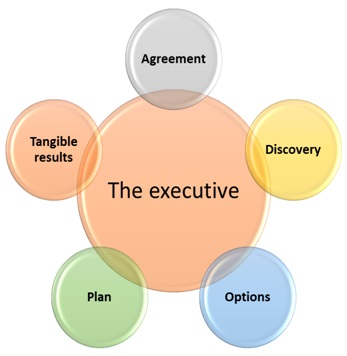A Coaching Model Created by Fadwa Badalla
(Executive Coach, DENMARK)

1. Background and purpose
Executives in international companies face many challenges in adopting an effective leadership style. Firstly, they have to navigate in markets that constantly changing due, e.g., geopolitical factors, shifts in customer behaviors, or technology disruptions. Secondly, they have to enable multi-national teams to work effectively together, adopting a style that works across cultures. Thirdly, they have to communicate with a diverse set of internal and external stakeholders.
The purpose of the ADOPT coaching model is to help executives find and adopt a leadership style that is effective for them. I believe this style is highly dependent on the company they are leading, the environment, and the individual. This is why a coaching approach is suitable here.
The role of the coach will be to facilitate that the client becomes clear what type of leader he/she wants to become, reflective about the situation today and how far the executive is from achieving that goal. This includes self-discovery of the barriers holding him/her back. The coach will help the executive to shift perspectives on how to overcome barriers, to achieve a clear commitment to a set of specific actions. As an overall result, the client will also develop an ability to think through these steps when the environment changes and adaption of a changed leadership style may be required.
2. AGREEMENT: Deciding on the outcome for the coaching process
The coach helps the client to define a clear goal of what they need to work on. The coach will facilitate a discussion with the client about what to expect and what not to expect in the coaching process and the role of the coach versus the role of the client.
The coach partners with the client and defines a specific agreement covering what outcome the client is trying to achieve and how to measure that it is successfully achieved. The coach and the client will agree on the process to achieve these objectives.
The overall outcome of this step is a clear agreement between the client and the coach and the way forward to accomplish that.
3. DISCOVERY: Developing an understanding of the context, situation, and barriers
During this step, the coach will help the client understand more about what the real issues are and dig deeper in terms of clarifying the leadership roadblocks and challenges the client is facing.
Together with the coach, the client will define the context he/she is leading in, i.e., industry, company, and team setting, as well as where he/she is today vis-à-vis the ambition.
The client will then discover the obstacles that could get in the way of improving leadership. The coach will help the client identify root causes and gain awareness to move forward. By doing that the client will be able to look at what options are available to take the next step.
4. OPTIONS: Exploring the opportunities for change
This part of the coaching process will leverage the awareness established in the previous step as a start point for exploring opportunities and possibilities for change. The client will identify viable options for addressing the leadership roadblocks. The coach enables the client to explore the solution space widely to find the forward-looking themes that the client finds important and realistic to pursue.
Although there are options, the coach helps the client prioritize the most tangible option that the client thinks will work best for him/her. The coach will support the client so options are clear and concrete and can be committed to in the next step.
5. PLAN: Committing to concrete actions
The coach will help the client turn the solution themes into concrete day-to-day actions that the client will commit to improving his/her leadership style. The coach and the client will partner to sequence the actions into a realistic plan, committed, and where progress can be tracked. This also includes that the client explores which resources could help hold them accountable to their leadership goals.
6. TANGIBLE RESULTS: Harvesting the benefits of the progress
This is the final step of the coaching model where the client reflects on what the progress is towards the agreed objectives. Here the coach will help the client see the results of his/her actions and use small successes as motivational factors for continuing the process.
The coach will encourage the client in identifying solutions to potential problems in achieving progress, thereby going into the discovery step again and repeating the process. The coach helps the client see the gradual adoption of their aspired leadership style during the coaching journey and a shift in mindset towards change and continuous improvement.